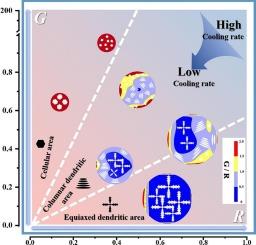Particle size-dependent solidification heterogeneity: Simulation and experimental decoupling of gas-atomized Ni-based superalloy powders
IF 4.6
2区 工程技术
Q2 ENGINEERING, CHEMICAL
引用次数: 0
Abstract
The microstructural uniformity of nickel-based superalloy powders for additive manufacturing has been recognized as a critical factor influencing the performance of built components. However, the particle-size-dependent solidification mechanisms during gas atomization remain poorly understood. In this study, the temperature fields and solidification histories of droplets with varying diameters were reconstructed through coupled thermo-fluid dynamics simulations. Combined with multi-scale characterization techniques, the effects of particle size on solidification structure, elemental segregation behavior, and grain structure were systematically investigated. The results revealed that cooling rate decreased with increasing particle size. Fine powders exhibited a cellular solidification structure due to rapid cooling, whereas coarse powders developed coarser dendritic morphologies, with the secondary dendrite arm spacing following a power-law relationship with particle size. In terms of solute segregation, positive segregation of Nb and Ti was observed in larger particles under near-equilibrium diffusion conditions, while Mo exhibited negative segregation due to diffusion limitations. Rapid solidification in smaller particles led to solute trapping and the formation of non-equilibrium microstructures. Grain structure analysis showed that smaller particles contained fewer but larger grains, whereas larger particles exhibited a multi-scale microstructure composed of both equiaxed and columnar dendrites. This work elucidated the size-dependent solidification pathways and microstructural evolution in gas-atomized nickel-based superalloy powders, providing a theoretical foundation for the tailored design and microstructural control of nickel-based superalloy powders for high-performance additive manufacturing applications.

颗粒尺寸依赖性凝固不均匀性:气雾化镍基高温合金粉末的模拟与实验解耦
增材制造用镍基高温合金粉末的组织均匀性是影响零件性能的关键因素。然而,在气体雾化过程中,依赖于颗粒尺寸的凝固机制仍然知之甚少。在本研究中,通过热流体动力学耦合模拟,重建了不同直径液滴的温度场和凝固过程。结合多尺度表征技术,系统研究了晶粒尺寸对凝固组织、元素偏析行为和晶粒组织的影响。结果表明,冷却速率随颗粒尺寸的增大而减小。由于快速冷却,细粉末表现出细胞凝固结构,而粗粉末则表现出较粗的枝晶形态,次级枝晶臂间距与颗粒尺寸呈幂律关系。在溶质偏析方面,在接近平衡扩散条件下,较大颗粒中Nb和Ti呈现正偏析,而Mo由于扩散限制呈现负偏析。小颗粒的快速凝固导致溶质捕获和非平衡组织的形成。晶粒结构分析表明,小颗粒的晶粒数量少而体积大,而大颗粒的晶粒结构由等轴枝晶和柱状枝晶组成。本研究阐明了气雾化镍基高温合金粉末的尺寸依赖性凝固路径和显微组织演变,为高性能增材制造应用中镍基高温合金粉末的定制化设计和显微组织控制提供了理论基础。
本文章由计算机程序翻译,如有差异,请以英文原文为准。
求助全文
约1分钟内获得全文
求助全文
来源期刊

Powder Technology
工程技术-工程:化工
CiteScore
9.90
自引率
15.40%
发文量
1047
审稿时长
46 days
期刊介绍:
Powder Technology is an International Journal on the Science and Technology of Wet and Dry Particulate Systems. Powder Technology publishes papers on all aspects of the formation of particles and their characterisation and on the study of systems containing particulate solids. No limitation is imposed on the size of the particles, which may range from nanometre scale, as in pigments or aerosols, to that of mined or quarried materials. The following list of topics is not intended to be comprehensive, but rather to indicate typical subjects which fall within the scope of the journal's interests:
Formation and synthesis of particles by precipitation and other methods.
Modification of particles by agglomeration, coating, comminution and attrition.
Characterisation of the size, shape, surface area, pore structure and strength of particles and agglomerates (including the origins and effects of inter particle forces).
Packing, failure, flow and permeability of assemblies of particles.
Particle-particle interactions and suspension rheology.
Handling and processing operations such as slurry flow, fluidization, pneumatic conveying.
Interactions between particles and their environment, including delivery of particulate products to the body.
Applications of particle technology in production of pharmaceuticals, chemicals, foods, pigments, structural, and functional materials and in environmental and energy related matters.
For materials-oriented contributions we are looking for articles revealing the effect of particle/powder characteristics (size, morphology and composition, in that order) on material performance or functionality and, ideally, comparison to any industrial standard.
 求助内容:
求助内容: 应助结果提醒方式:
应助结果提醒方式:


